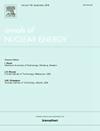Prediction of composite neutron source spectra by combination of JENDL-5 and PHITS
IF 1.9
3区 工程技术
Q1 NUCLEAR SCIENCE & TECHNOLOGY
引用次数: 0
Abstract
A novel robust method has been developed to simulate the performance of composite neutron sources composed of an alpha-emitting actinide and a light nucleus with low neutron separation energy. This method is based on the JENDL-5 cross-section data library and the Monte-Carlo radiation transport code PHITS. In contrast to previously devised methods, this approach can predict various quantities of the sources, such as actinide grain size dependence, absolute neutron emission intensity, energy spectra of neutrons and parasitic photons, neutron multiplicity, and time structure, with little approximation.
The accurate calculation of stopping power of alpha rays in actinide grains and light elements, as well as the use of (, n) reaction evaluated cross sections, which is one of the unique features of PHITS Ver.3.34 and its later versions, are the essences of the method. This method allows for the calculation of quantities important for practical applications, such as detection signal frequency, coincidence event rate, and the impact of parasitic gamma-rays.
求助全文
约1分钟内获得全文
求助全文
来源期刊

Annals of Nuclear Energy
工程技术-核科学技术
CiteScore
4.30
自引率
21.10%
发文量
632
审稿时长
7.3 months
期刊介绍:
Annals of Nuclear Energy provides an international medium for the communication of original research, ideas and developments in all areas of the field of nuclear energy science and technology. Its scope embraces nuclear fuel reserves, fuel cycles and cost, materials, processing, system and component technology (fission only), design and optimization, direct conversion of nuclear energy sources, environmental control, reactor physics, heat transfer and fluid dynamics, structural analysis, fuel management, future developments, nuclear fuel and safety, nuclear aerosol, neutron physics, computer technology (both software and hardware), risk assessment, radioactive waste disposal and reactor thermal hydraulics. Papers submitted to Annals need to demonstrate a clear link to nuclear power generation/nuclear engineering. Papers which deal with pure nuclear physics, pure health physics, imaging, or attenuation and shielding properties of concretes and various geological materials are not within the scope of the journal. Also, papers that deal with policy or economics are not within the scope of the journal.
 求助内容:
求助内容: 应助结果提醒方式:
应助结果提醒方式:


